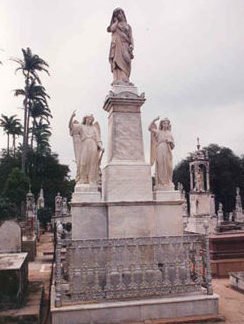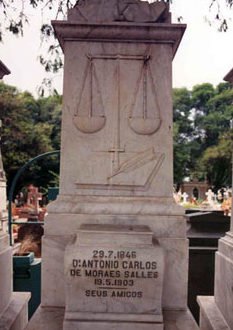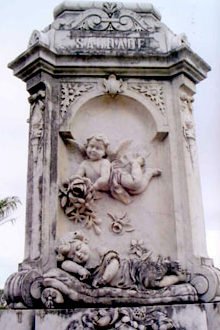Cemitério da Saudade
Campinas (SP)
Campinas (SP)
The early settlement of Campinas is associated with the opening of trails westward from São Paulo to the hinterlands of Goiás and Mato Grosso. One such trail, opened between 1721 and 1730, was named “Caminho dos Goiases”. Soon an inn was established on the side of the trail that offered lodging to tired, hungry mule-drivers traveling between the settlements of Jundiaí and Mogi-Mirim. This hostelry became known as “ Campinas do Mato Grosso”, an allusion to the three relatively small treeless meadows amidst the nearby dense forest.
Campinas was officially founded in 1774, when Captain-General Dom Antônio Luiz de Souza Botelho Mourão, governor of the captaincy of São Paulo, signed various bills, including the one that legally created the district of Conceição de Campinas.
The Saudade Cemetery, founded on October 10, 1880, in fact is a burial complex that comprises another five adjoining cemeteries: the Curas D’ars (for yellow fever victims); São Miguel e Almas (for Catholic blacks); Terceira Ordem do Carmo and Santíssimo Sacramento (for Catholic whites), and São José. The Saudade Cemetery may be considered an “open-air museum.”
Campinas stnds out as one of the fastest growing cities in the state of São Paulo, in southeastern Brazil. According to an estimate by the Secretary of Planning of the Township of Campinas (//www.campinas.sp.gov.br), its current population of about one million earns US$ 5,800 per capita.

The Saudade Cemetery is a public graveyard, run by the city administration, which follows the model of secularized cemeteries comprised by blocks and sub-blocks giving access to avenues, lanes and paths. It is located in the Swift district. In the past this was the exit to the city of Valinhos. Currently the cemetery is overpopulated with 318,000 interments in 32,000 tombs scattered in 181,500 square meters of land.

The most notable personalities in the history of the city of Campinas are buried at this cemetery. Among the family mausoleums, the tombs of Eleonor Penteado, Francisco Glicério, João Francisco de Andrade Franco, Baron Geraldo de Rezende and Hercules Florence (pioneer of photography in Brazil) and the chapel mausoleums of Bento Quirino and the Baron of Atybaia are particularly remarkable.

An investigation is under way to ascertain whether the administration building of Saudade Cemetery, built in 1899, was designed at the office of architect Ramos de Azevedo, in São Paulo. The artistic and historical significance of Saudade Cemetery mausoleums, chapels and tombs dated from the 19th century and early 20th century is commendable. Many of these monuments were imported from Italy, such as those built by sculptors and marble workers Giuseppe Tomagnini and son; others were made in Campinas by the Velez Family, Brothers Coluccini, and Fernando Martinelli and Brothers. The styles of the handsome grave markers include neo-classical, art nouveau, art deco, and modern. The wealth amassed during the coffee boom sponsored all monuments that symbolize and reflect the taste of the coffee bourgeoisie.



Cemetery is a cultural institution of the Western society. The preservation of its heritage is one way to legitimize it, as well as artistics and cultural activities carried on in situ.
+ 55 62 3225 5957 | + 55 62 996 143 427
E-mail: maelizia@terra.com.br

 Cemitério São João Batista
Cemitério São João Batista 



